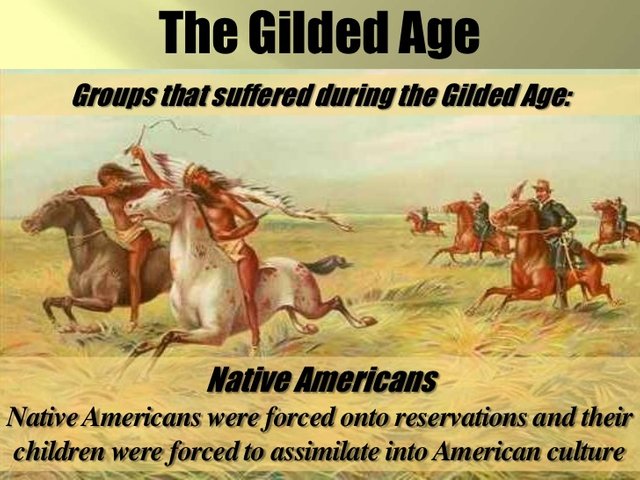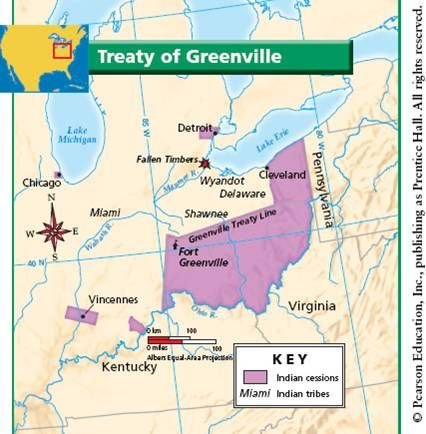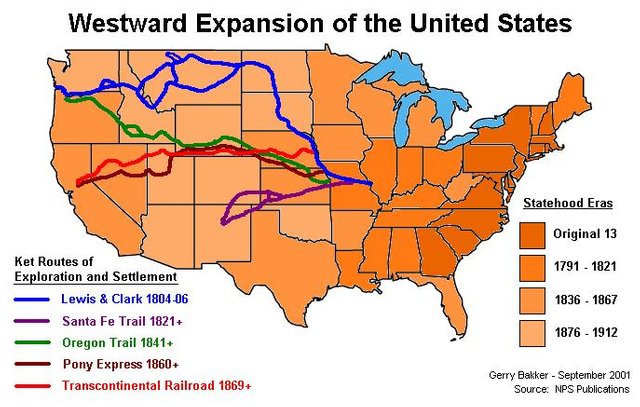WESTWARD EXPANSION - History of USA #9
- GILDED AGE
As industrialism took over the eastern states at the dawn of the Gilded Age, immigrants came by millions to build new lives in the United States. The Gilded Age was the period in history following the American Civil War (1861-65) and the Reconstruction Era, characterized by a ruthless pursuit of profit, an exterior of showiness and grandeur, and immeasurable political corruption. Most immigrants during the time settled in the East. The Southern states were populated largely with African Americans who had been freed from slavery. Because the South was less affected than the East by the Industrial Revolution (approximately 1878-1900), the population growth in that region was not as explosive.

- WILD WEST FOR AMERICANS
The region of the United States that was still relatively open was the West. California was home to hundreds of thousands of Chinese immigrants who crossed the Pacific Ocean to work as servants and railroad laborers and in other positions most workers considered too dirty or dangerous. Mexican immigrants crossed the border into Texas and worked mostly as field hands, taking jobs where they could find them. For the most part, the west was still wild in the minds of Americans.
- HOME OF THE NATIVE AMERICANS
The phrase "Wild West" conjured images of dusty plains and ferocious Indians, as Native Americans were called. They were also referred to as savages and thought to be brutal in war. Clashes between Native Americans and the newer inhabitants of the Americas had been occurring since the 1600s. Tribes in the Northeast forged respectful relationships with fur traders and missionaries, but English settlers lived in constant fear of attacks.
- TREATY OF GREENVILLE
After the American Revolution, the new government had to deal with the major problem i.e. how to convince the Native American tribes in the Northwest Territory (land north of Ohio River and east of Mississippi River) to leave their land so white settlers could move in. After many battles, the Treaty of Greenville was signed in 1795, and Native American tribes left Ohio for Indiana. The treaty allowed tribes to retain hunting rights to certain land and it promised them $20,000 in immediate payment in the form of goods needed for everyday living. Tribes also would receive another $9,500 in goods annually to be split among them. The US government became dissatisfied with this agreement as settlers soon began moving to Native American lands in Indiana.

- FORMATION OF CONFEDERACY
The breach of contract angered the tribes, and they formed a Confederacy led by Shawnee Chief Tecumseh. The great warrior was killed in the War of 1812. His death ended Native American resistance from the Northwest Territory, and the US government was able to develop a policy for removing the Native Americans from the region.
- REALLOCATION ON INDIAN RESERVATIONS
By 1860 most Native Americans had been relocated across the Mississippi River onto Indian reservations, federal land allotted to and manged by Native Americans. The tribes did not leave their homeland willingly or without a struggle.
- PLAIN INDIAN WARS
In addition to many smaller conflicts, the relocation program resulted in Seminole Wars (1817-18; 1935-42) and the Black Hawk War (1832). These wars were a foreshadowing of what would be more than twenty years of battles between Native Americans and Whites known as Plain Indian Wars. More than two hundred battles were fought between 1869 to 1878 alone. By the late 1870s the government wanted to "Americanize" Native Americans. Reservation life forced upon them white values, including Catholicism and European American lifestyles and attitudes.
- BUILDING THE WEST
EXPANSION OF THE RAILROAD INDUSTRY
The rapid expansion of the railroad industry was the main factor in promoting Westward Expansion and closing the American frontier. In 1865 the West and the Great Plains had just 960 miles of track. By 1900, the region boasted over 90,000 miles of track. Five routes linked the East with the West.
PROMOTION OF WEST BY THE FEDERAL LAND GRANT PROGRAM
Before the final stake was pounded in to connect East with West via the Transcontinental Railroad in 1869, passengers and freights could travel only as far as Kansas and Colorado by rail. While this was a major accomplishment, the lack of railroads in the West prohibited human settlement on a large scale. The development of the Pacific Railroad changed that. Now that the West had a railroad, immigrants could pursue the American dream, one of great hope of prosperity and riches, as far as the Pacific Coast. European immigrants entered America mainly at Ellis island in New York, where they tended to settle. Beginning in 1869, however, they had the option of heading to West where land was more plentiful. Beginning in the early 1800s, the government began giving grants to various groups, such as those who wanted to build homes in the West. As the railroads were being built, these grants were extended to include the financing of railroad construction. The government designated strips of land in areas it wanted people to settle. It designated alternative strips of land to railroad construction and gave that land to railroad companies that promised to build. The companies then sold the settlement land to European immigrants and used the money to pay for railroad construction. About 18,738 miles of railroad track were built using funds from the land grants, a figure that represents 8 percent of all US railroad construction. A lesser-known aspect of the Federal Land Grant Program was the promotion of the West by the railroads themselves. It is generally accepted that most immigrants left their homeland in search of a quality of life they knew they could never have at home. But American Railroad companies fed on the immigrants' needs and desires by promoting their land in Europe. Many railroads hired clergy and prominent businessmen to help influence immigrants to come to the West. The railroads focused their efforts on the non-English-speaking countries of Northern Europe.

It was a common belief that these groups had a better work ethnic than others and that they would work harder, complain less, and produce more. The railroads published promotional brochures and pamphlets in several languages. These advertisements promised wealth and success, many times to a degree not possible even for the hardest of workers. Between 1870 and 1900, after the completion of the Transcontinental Railroad, 430 million acres were settled. Most of the settlers in this time period were farmers, both American and immigrant.
Very informative!
Thanks
good post. follow me @goga
Thanks for the compliment :)
Congratulations! This post has been upvoted from the communal account, @minnowsupport, by fatimaa from the Minnow Support Project. It's a witness project run by aggroed, ausbitbank, teamsteem, theprophet0, someguy123, neoxian, followbtcnews/crimsonclad, and netuoso. The goal is to help Steemit grow by supporting Minnows and creating a social network. Please find us in the Peace, Abundance, and Liberty Network (PALnet) Discord Channel. It's a completely public and open space to all members of the Steemit community who voluntarily choose to be there.
This post has received a 0.52 % upvote from @drotto thanks to: @banjo.
One of the worst genocides in history took place there. Fake White "Americans" are hypocristes because they claim they are bringing freedom to the world whenever they invade foreign countries yet they are themselves occupying the land of the real Americans; Natives.